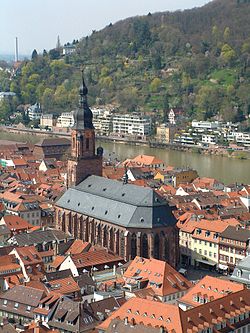Church of the Holy Spirit, Heidelberg


The Church of the Holy Spirit (German: Heiliggeistkirche) is the largest and most notable church in Heidelberg, Germany. The church, located in the marketplace in the old town centre of Heidelberg, was constructed between 1398 and 1515, and planned as the burial place of the Electors of the Palatinate and as a representative church of the Palatinate royal seat. In the Palatine War of Succession, the princely graves of the Electors were destroyed; today only the founder of the church, Elector Ruprecht III, who reigned as King of Germany until his death in 1410, is located in the church. The church was also the location of the founding, and the original repository of, the Bibliotheca Palatina.
Early history[]
A church on the site consecrated to the Holy Spirit is first attested to in a manuscript from 1239. In 1398, the foundations of the current late Gothic church were laid on the site of a late Romanesque basilica which, in turn, had been erected in the place of an even older church. Thus the current church is the third sacral building on the site.
Construction[]

Documents name , who was also mayor of Heidelberg for a time, as the master builder. In the usage of the time, the term "master builder" referred not to the architect but the financial coordinator. The only known architects during the church's construction are Hans Marx, who worked on the church until 1426, as well as Jorg, who was responsible until 1439. Both men probably supervised work on the nave. Under the reign of Prince-elector Frederick I a noted specialist in the construction of church towers, , came from Mainz to Heidelberg and was probably responsible for the execution of the primary work on the spire of the Church of the Holy Spirit. Nevertheless, the steeple was completed by Lorenz Lechler.
Stages of construction[]
The construction took place over one hundred and fifty years. The Choir was consecrated in 1411 and the nave was finished in 1441. Probably in the same year the construction of the steeple was started. The work was interrupted until 1508 and the tower was finished in 1544. In 1709, after the church had been set on fire by the French during the War of the Palatinian Succession, it was rebuilt and received a baroque spire.
Architecture[]
Exterior[]
Interior[]
Stained glass[]
Heidelberger Fensterstreit[]
Use[]

In the 14th century, the Church of the Holy Spirit took over as parish church from St. Peter's Church, which became the university church for the University of Heidelberg.
Originally, the Church of the Holy Spirit contained the tombs of the Palatinate electors, destroyed by fire during the War of the Palatine Succession. The only remaining tomb is that of Prince-Elector Rupert III, the founder of the church, which is still preserved.

The building on the right in the background is the famous Hotel zum Ritter
The famous Palatine Library, the Bibliotheca Palatina, was founded and at first kept in the gallery of the Church of the Holy Spirit, where good light for reading was available. During the Thirty Years War from 1618 to 1648, this collection of manuscripts and early printed books was taken as booty by Maximilian I, Elector of Bavaria and presented to the Pope. Of the approximately 5,000 books and 3,524 manuscripts taken, a mere 885 were eventually returned in 1816. The rest form the Bibliotheca Palatina section of the Vatican Library. For the University Jubilee, many of these books were briefly brought back and displayed in Heidelberg.

In the course of its history, the Church of the Holy Spirit was used by both Catholics and Protestants, even simultaneously. Starting in 1706, a partition was inserted so that both congregations could hold their services without any mutual disturbance. In 1720, Karl III Philip, Elector Palatine came into conflict with the town's Protestants as a result of fully handing over the Church of the Holy Spirit to the Catholics. Karl Philip gave way, due to pressure from Prussia, the Dutch Republic, and Sweden and repartitioned the wall. In 1936 the separating wall was removed and the church is now exclusively Protestant (Protestant Church in Baden).
At the beginning of the 1970s, the steps at the rear of the Church of the Holy Spirit were popular with the Hippies and the Flower Power movement and became a tourist attraction during this time. In 1972, a rock concert by and the English band Quintessence was organised in the church and attended by students and Hippies alike.[citation needed]
See also[]
| Wikimedia Commons has media related to Heiliggeistkirche Heidelberg. |
- Heidelberg
- Category:Burials at the Church of the Holy Spirit, Heidelberg
References[]
- Dethard von Winterfeld: Heiliggeistkirche Heidelberg. München-Zürich 1982
- Heidelberg, ISBN 3-921524-46-6
External links[]
- Information from the City of Heidelberg about Heiliggeistkirche
- Heiliggeistkirche parish
- church architecture
- Information on concerts and choirs at Heiliggeistkirche
- Heidelberg im Bild - Photos of Heiliggeistkirche
- Die Heiliggeistkirche zu Heidelberg - 500+ photos, art history, building history
- Buildings and structures in Heidelberg
- Burial sites of the House of Cirksena
- Burial sites of the House of Württemberg
- Burial sites of the House of Wittelsbach
- Former Roman Catholic church buildings
- Gothic hall churches in Germany
- History of Heidelberg
- Protestant churches in Baden-Württemberg
- Rebuilt churches in Germany
- Tourist attractions in Heidelberg
- United Protestant church buildings in Germany
